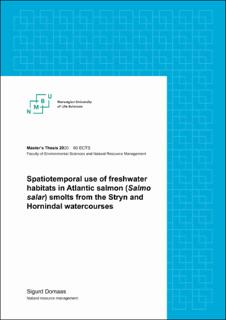| dc.description.abstract | The Atlantic salmon (Salmo salar) is a species with a lot of variation in portraited life-historystrategies – the most common one, includes a migration from its natal river to the Atlantic Ocean at a vulnerable stage in life. The smolt migration through rivers and lakes is usually studied in combination with manmade reservoirs and hydropower dams, and many studies have demonstrated substantial smolt mortality through such lakes.
In this study, multiple transects of acoustic receivers were placed throughout the migration course, and in April 2019 a total of 199 salmon presmolts were caught (electrofishing) and tagged with acoustic transmitters. The purpose was to identify how environmental drivers like water discharge and water temperature affect the smolt migration, and how two large natural lakes affect the smolt migration in two non-hydropower affected watercourses in Western Norway: The Hornindal watercourse with the river Horndøla that runs into lake Hornindalsvatnet which empties into the river Eidselva, and Stryn watercourse with the river Hjelledøla that runs into lake Strynevatnet which empties into the river Stryneelva.
Initiation of migration for the tagged smolts was found to be correlated differently to water discharge and day of year in the four rivers. In Eidselva, initiation was correlated to date, water discharge and the relative change in water discharge from the previous day. In Stryneelva, initiation was correlated to date and the relative change in water discharge, whilst in Horndøla it also correlated to the interaction between the mentioned drivers. In Horndøla it correlated to the water discharge. The tagged smolts from all four rivers were showing clear signs of multiple migration peaks arriving in the estuaries (Eidselva and Stryneelva) and river mouths (Horndøla and Hjelledøla) almost a month apart. In Eidselva, Stryneelva and Hjelledøla the first migration peak coincided with increased water discharge during the days around April 23, and a second peak during the days around May 20. In Horndøla the first migration peak took place during the days around May 19, and a second peak in the days around June 1. The Horndøla smolts were found to be late migrators, both due to a later start and the delay caused by traversing the Hornindalsvatnet, where the median progression rate was 0.16 body lengths per second, bringing the migration duration up to almost thirteen weeks in the Hornindal watercourse. None of the Hjelledøla tagged smolts were observed downstream of Strynevatnet.
Apparent survival through the watercourses was estimated using a sequential approach to Cormack-Jolly-Seber models on the detection data. The apparent survival (95% CI) was estimated to be as low as 2% (0%–12%) through Strynevatnet and 19% (3%–46%) through Hornindalsvatnet. The apparent survival (95% CI) from release to the fjord was estimated to 4% (0%–28%) and 47% (29%–63%) for the Horndøla and Eidselva smolts, respectively, and 0% and 33% (25%–51%) for the Hjelledøla and Stryneelva smolts, respectively. Survival was found to be size related in Hornindalsvatnet and the Eidselva estuary, and predation avoidance behavior was seen in the tagged smolts. Depth use in Strynevatnet was correlated to smolt weight, were depth decreased with weight, to date, where individuals lighter than ~27 grams went deeper whilst heavier individuals went shallower as the year progressed, and to night and daytime, where the tagged smolt went shallower during night. The night and daytime difference was the strongest in late April and evened out by mid-June. In Hornindalsvatnet, one individual was responsible for more than 95% of the data, and no analyses were done on depth use.
This study has increased the knowledge on the smolt migration of the Atlantic salmon stocks in the Hornindal and Stryn watercourses. It has shown that very few, or none, of the tagged smolts from the rivers Hjelledøla and Horndøla made it to the fjord during the spring run in 2019. | en_US |

